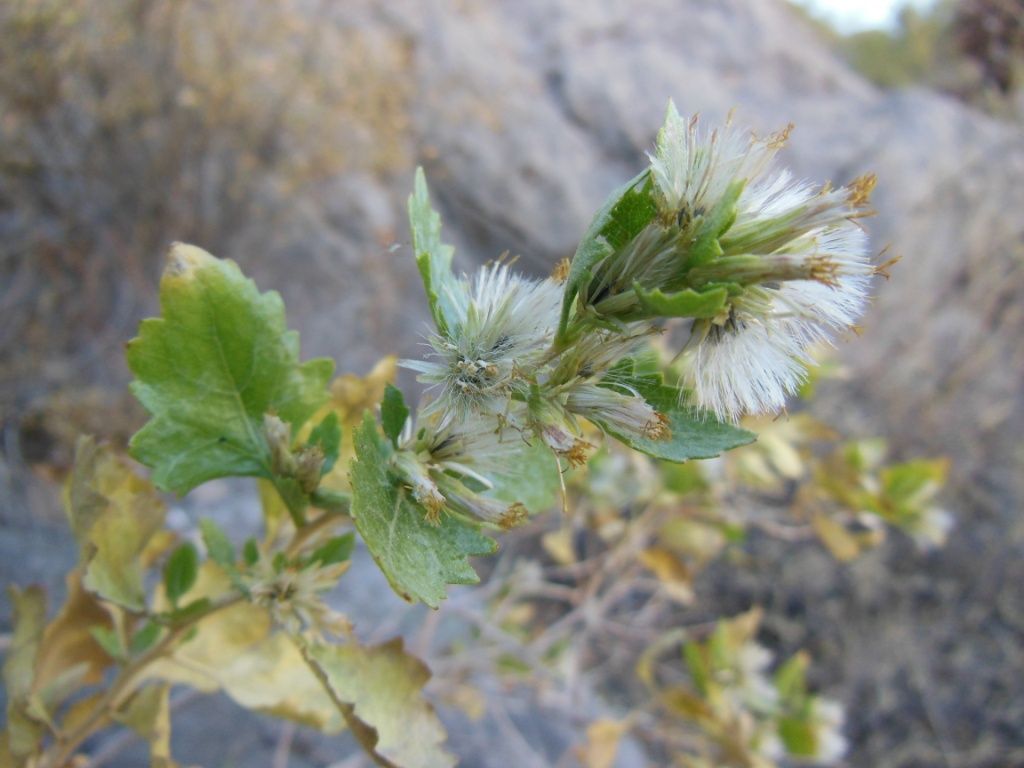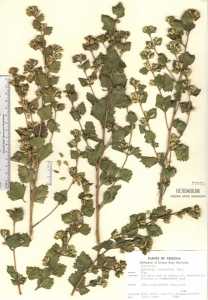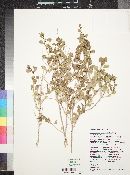|
|
|
|
Family: Asteraceae
resinleaf brickellbush
|
Shrubs, 100-150 cm. Stems (ascending) branched, pubescent, sometimes glandular-pubescent. Leaves alternate; petioles 4-10 mm; blades 3-nerved from bases, rhombic-ovate, 10-40 × 10-20 mm, bases cuneate, margins laciniate-dentate, apices acute to obtuse, faces glabrate or gland-dotted. Heads in dense, paniculiform arrays. Peduncles 5-40 mm, pubescent. Involucres narrowly campanulate, 7-11 mm. Phyllaries 35-40 in 5-7 series, 3-5-striate, unequal, (glabrous, ± chartaceous) margins narrowly scarious (apices acute to acuminate); outer ovate, inner lanceolate. Florets 16-17; corollas cream, 6-7 mm. Cypselae 2-3 mm, pubescent; pappi of 18-24 white, barbellate bristles. 2n = 18. Flowering Oct-Apr. Sandy to granitic soils, limestone slopes, granitic cliffs; of conservation concern; 500-1600 m; Ariz., N.Mex., Tex. FNA 2006, Wiggins 1964, Martin and Hutchins 1980, Kearney and Peebles 1969 Common Name: resinleaf brickellbush Duration: Perennial Nativity: Native Lifeform: Subshrub General: Shrubs, 1-1.5 m tall; stems slender, flexuous, gray-brown, woody at base or throughout, with exfoliating bark; branches smaller, slender, puberulent, and leafy. Leaves: Mostly alternate, on petioles 4-10 mm long; blades rhombic-ovate, 1-4 cm long by 1-2 cm wide, 3-nerved from base, with a leathery texture; bases cuneate and entire; apices acute to obtuse; margins coarsely lacinate-dentate; faces strongly reticulate, glabrate or gland-dotted, often shiny. Flowers: Flower heads discoid, arranged in dense panicles on short, pubescent peduncles, these 0.5-4 cm long; involucre (ring of bracts wrapped around the flower head) narrowly campanulate, 7-11 mm high, the bracts (phyllaries) 35-40 in 5-7 series, unequal, 3-5 striate, brown to straw colored with narrowly scarious margins, rounded to obtuse at the apex, often resinous; florets 16-17, all discs, the corollas cream-colored, 6-7 mm long. Fruits: Achenes 2-3 mm, pubescent, strongly ribbed, topped with a pappus of 18-24 white, barbellate bristles. Ecology: Found on sandy to granitic soils, limestone, and along granitic cliffs, from 500-6,000 ft (152-1829 m); flowers October-May. Distribution: AZ, s NM, sw TX; south to n MEX. Notes: Brickellia is a genus of shrubs and perennial herbs with all disc flowers, these usually white to cream colored; flower heads wrapped in several rows of bracts (phyllaries), the outer rows shorter than the inner rows; and 10-nerved seeds topped with white tufts of bristles. Distinguished from the similar B. californica by its longer peduncles (> 5 mm) and its leaves with cuneate bases and irregularly serrate margins. B. baccharidea is of conservation concern given its limited distribution. Ethnobotany: Unknown, but other species in the genus have uses. Etymology: Brickellia is named for Dr. John Brickell (1749-1809), a botanist and physician who worked in Georgia; baccharidea refers to the plant being like the genus Baccharis with its resinous leaves. Editor: SBuckley 2010, FSCoburn 2015, AHazelton 2015 |





